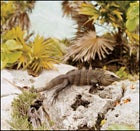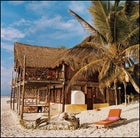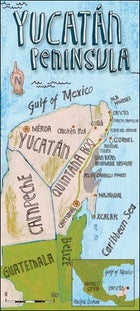“CAN YOU IMAGINE the parties they must have had at this place?” Matt Perlman says. Standing on the sun-warmed deck, we let our eyes roam for a while. Before us the aqua Caribbean Sea, behind us the jungles of Mexico’s Yucatán Peninsula, all around us the villa of Pablo Escobar. That’s right: Colombian drug lord Pablo Escobar.
yucatan peninsula
 An iguana at the Tulum ruins
An iguana at the Tulum ruinsyucatan peninsula
 Amansala Resort, Tulum
Amansala Resort, Tulumyucatan peninsula
 A guest at Hotel Básico, in Playa del Carmen.
A guest at Hotel Básico, in Playa del Carmen.yucatan peninsula

��
A hundred yards offshore, two frigate birds drift over the Belize Barrier Reef, the second-longest reef in the world a crackly maze alive with brilliant mustard-yellow brain corals, lascivious queen conchs, and sea turtles. But I’m having a hard time enjoying the view, given the Caligula-like scenes playing in my head.
The outer wings of Escobar’s 20,000-square-foot mansion, near Tulum, contain tiny rooms the size of cells, and an underground passageway once connected the main house with a guesthouse down the beach. In the late eighties, before the cocaine kingpin was killed, the Mexican military seized the house and let looters and tropical storms strip it to a concrete skeleton. The deck we’re standing on contains only broken beer bottles and cigarette butts, the party trash of local teens. “I bet he had presidents out here,” Perlman says.
As if overhearing my thoughts Isn’t this just a little creepy? Perlman assures me that Pablo’s casa has been exorcised of bad karma; Perlman’s sister, Melissa, an American hotelier who runs Amansala, an “eco-chic” resort just up the beach, invited a Tibetan monk to cleanse the energy throughout��the��property by carrying a torch from room to room and chanting prayers. Perlman, Amansala’s adventure guide, says Melissa recently struck a deal with the Mexican government to turn the villa into a high-end hotel called Casa Magna; the guesthouse opened early this year, and the main mansion is slated to open this coming January.
Pablo’s villa illuminates one of the irrefutable truths about the Yucatán coast: No matter how far you run, no matter how remote your hideaway, the southward march of development will eventually catch up to you. Tulum in Pablo’s day was an isolated fishing town, known for its seaside Maya temples perched on a spectacular headland. Today, it’s the hottest real estate market in the burgeoning state of Quintana Roo one of the fastest-growing travel destinations in the world. Movie stars and yoga masters seek out its thatch-roofed bungalows to bliss out on the town’s funky mellow vibe. And tourism development is charging down the coast at such breakneck speed that it raises a question in the mind of every traveler seeking solace in Mexico’s easternmost region: Is it possible to escape Cancún? To see for myself, I rented a Jeep there and pointed it south.
BEFORE THE COMING of the gringos, before there were tequila shooters and Señor Frog’s, before there were Girls Gone Wild and MTV’s Spring Break and the all-inclusive-package deal, the eastern coast of the Yucatán Peninsula was tangled and growly and wild. Jaguars, pumas, and tapirs roamed over unbroken tropical forest and mangrove swamplands. Maya villages and chicle plantations cropped up here and there, but human contact was so rare that when the American geographer Clinton Edwards rambled through the territory (now the state) of Quintana Roo in the fifties, he proclaimed it “Mexico’s empty quarter.”
Then, like Walt Disney scouting for acreage in Anaheim, Mexican officials surveyed the Yucatán in search of the perfect site for the country’s first master-planned resort, and in 1970 they chose an eight-mile-long barrier island near the peninsula’s northeastern tip. Kan Kun, as it was originally known “Pot of Snakes” in Mayan succeeded beyond its planners’ wildest dreams. Every year, upwards of seven million tourists flock to the city’s Zona Hotelera, which may be the most densely packed piece of rack-rate real estate south of the Las Vegas Strip. The Mexicans who rake the beaches and run the restaurants and manage the city’s $2-billion-plus tourist economy call the place Gringolandia.
Even as Cancún prospered, the coast to the south remained a frontier. Until recently it was still possible to drive down Highway 307 to sleepy towns like Playa del Carmen and Tulum and experience Mexico in all of its rough-edged, empty-beached, warm-bottle-of-Negra-Modelo glory. But in an effort to push Cancún’s prosperity beyond the Zona, in the eighties the state tourism agency invited development from Cancún to Tulum, later branding the 80-mile stretch the “Riviera Maya.”
As I barrel down the highway from Cancún, it’s clear that vast tracts of mangrove wetlands have been bulldozed to make way for all-inclusive resorts. In the past decade, Playa del Carmen has exploded, real estate prices have skyrocketed, and hotel rooms have increased from 3,500 to 30,000. In five years there will be 50,000. “Until recently, most of the money stayed in Cancún,” says Felipe Alvarado, assistant manager of KaiLuum Cito, a small, idyllic ecotourism resort some 200 miles from Cancún, near Majahual. “The government is trying to move that money south.”
The money is moving so fast, in fact, that some small-scale resorts have been pushed out of business. KaiLuum Cito is owned by Clayton Ball, an American whose family pioneered ecotourism in the Yucatán in 1976 with the original KaiLuum, an elegant tent camp on the beach 43 miles from Cancún that was forced to close last year. “We were leasing our land from an adjacent resort, and they got offered $14 million for the property,” Ball tells me. “They held out for a while, but finally the price went so high they sold it.” Anticipating that development will continue moving southward, Ball not only opened KaiLuum Cito; he also bought property even farther down the coast and is prepping it for KaiLuum’s next incarnation.
There have been other troubles, too. By paving the mangroves, the big hotels destroyed natural hurricane buffers and habitat for a vast range of wildlife, from anteaters and iguanas to migratory songbirds. Business owners complained that the all-inclusive resorts attracted visitors who, having paid for their food and drinks up front, were too cheap to sample the locally owned bars and restaurants. Boomtowns like Playa del Carmen were growing so fast, sewage systems and treatment plants couldn’t keep up, and the groundwater was becoming polluted. Gringolandia, it seemed, was sprawling out of control.
And then, surprisingly, state and local officials rose up against the Cancúnization of the Riviera Maya. Fearful of losing the natural “green gold” landscape that attracts more adventurous travelers, the state of Quintana Roo in 1994 passed strict zoning laws that limit the height of hotels and require tough new environmental protocols. Perhaps even more startling, the state has actually enforced them. Four years ago, when Fairmont Hotels proposed a new megaresort called Mayakoba, north of Playa del Carmen, state officials asked the corporation to rework its original design to meet with the new environmental standards; Fairmont readily complied.
“Instead of one hotel next to another, we want the resorts to be surrounded by jungle,” says Dario Flota, executive director of the Riviera Maya Tourism Board. “We’ve got to keep the ecological conditions strong, because that’s what makes the Riviera Maya attractive.”
AS THE FIRST of the next generation of eco-friendly, non-all-inclusive resorts, Fairmont’s superluxe Mayakoba has been one of the most anticipated and scrutinized developments in the Riviera Maya’s recent history. The resort, which opened in May, sits on the coast 42 miles from Cancún very near Clayton Ball’s original KaiLuum site. But this is no bungalows-on-the-beach operation. My arrival is greeted by a swarm of valets who relieve me of my Jeep, whisk away my luggage, clasp my hand to a mango cocktail, and announce, “The grounds are yours.”
The gleaming marble lobby commands a sweeping view of the resort’s 590 over-the-top acres of pools, casitas, fairways, freshwater lagoons, and palapa-topped restaurants. Mayakoba aspires to become the Pebble Beach of the Riviera Maya, and it’s already well on its way. This coming February, the hotel’s Greg Norman designed golf course will host the Mayakoba Classic, the first-ever PGA Tour event held in Mexico. Within three years, if all goes according to plan, the site will include three adjacent villa-style, high-end hotels, all connected by freshwater lagoons (guests will motor around in electric-powered mahogany lanchas), with shared access to the greens.
Mayakoba is what Dario Flota has in mind when he talks about developments surrounded by jungle. “The law says we must protect 80 percent of the mangroves, so we designed Mayakoba to keep the mangroves intact,” Lyn Santos, the resort’s ecology manager, tells me during a tour of the compound. It’s an intriguing layout. The golf clubhouse, beachside restaurant, and pool are separated from the rest of the resort by a half-mile-wide swath of pristine mangrove wetland that provides habitat for anteaters, crocodiles, turtles, iguanas, and dozens of bird species.
The nature zone seems to be offering the desired storm protection, as well. “Last fall, when Hurricane Wilma hit, Cancún lost 7,000 hotel rooms. Because we had the mangrove buffer, all we lost was wet furniture,” Santos says.
A few miles south, in Playa del Carmen, the A-list hotels aren’t the big beachside resorts. They’re the boutique joints tucked on side streets off Quinta Avenida, Playa’s jumping nightlife district. Despite its growth, Playa’s cool reputation more Chateau Marmont than Marriott Marquis continues to draw a younger crowd away from Cancún. Nobody exemplifies the cultural blossoming better than Alejandro Rueda, Playa’s sultan of style. Rueda manages Deseo and Básico, the town’s famously hip hotels.
“When I arrived here five years ago, the hippies used to yell at me for wearing nice clothing,” Rueda tells me over drinks at Básico’s rooftop bar. “Well, those hippies sold their land, made millions, and moved farther south.”
Deseo, with its clean, neomodern design and poolside lounge beds, ushered in the town’s era of high design in 2001. “There is Playa before Deseo, and there is Playa after Deseo,” Rueda sniffs. Both hotels were designed by the hot young Mexico City interior decorator Héctor Galván. I stay at Básico, Galván’s Dadaesque creation, which opened last year. Instead of tile, the lobby floor is “carpeted” in truck-tire rubber. Barstools trussed into a cargo net sway ominously overhead. Rooms are named, not numbered. (Mine is Fernanda.) In the bar you’ll find Básico’s signature piece twin plunge pools inspired by oil drums. They’re the perfect place to cool off and hang out with your supermodel friends.
Playa may have lost its anonymity, but the town remains an excellent jumping-off point for exploring the jungles and waterways of the Yucatán coast. Xcaret and Xel-Ha (pronounced ISH-ka-ret and SHELL-ha), the area’s biggest eco-oriented theme parks, offer an overpriced mass-market taste of the region’s natural wonders, but for a more authentic backcountry experience I hook up with Alltournative, a Playa-based outfitter that has established a reputation for combining adventurous activities with ecologically and culturally sustainable development. Co-owner Gavin Greenwood sends me flying on a 60-foot-high zip line over the tropical forest and snorkeling in the Nohoch Nah Chich cenote. Cenotes are freshwater sinkholes that connect to the Yucatán’s vast network of underground rivers. You need expert-level diving certification to follow the water deep into the caves, but Alltournative’s dive guides can take snorkelers far enough into the stalactite-spiked caverns to get a peek at the drowned Maya underworld.
After drying off in the warm Mexican sun, the guides and I chow down on some achiote-spiced chicken and panucho tortillas prepared by local Maya chefs. “We partner with five local ranches and ejidos [land cooperatives], which own the zip-line forest and the cenote,” Greenwood explains. “About 200 local people job-share 100 positions in our company. They come in and work one week, then take the next week off to tend their farms. Five years ago locals were bringing in $35 a month; now they’re netting $400.” The Maya guides I speak with think it’s a pretty good deal; word has spread around the region, and Alltournative now attracts ambitious young people from outlying Maya villages.
TULUM, WITH ITS long stretch of blindingly white beach, has long been the Yucatán’s choicest escape. But change is on the way. On the narrow road along the beach, property-rights disputes with the ejidos have kept the resorts small along the southern section, since nobody can afford to pour millions into untitled land. But to the north (on the way to the famous Maya ruins), where property rights are more defined, at least one larger-scale resort is rising on the beach, and a sign nearby announces plans for THE TIDES TULUM, a Riviera Maya version of the Kor Hotel Group’s five-star condo resort in Miami Beach. It’s hard to say how long Tulum’s barefoot spirit will hold out.
South of town, Highway 307 turns away from the coast, blocked by the great forests of the 1.3-million-acre Sian Ka’an Biosphere Reserve, and narrows to a single lane in each direction. Gas stations stretch thin across the land. English speakers here are forced to dig into their high school Spanish. Aside from the agricultural town of Felipe Carrillo Puerto, the road runs long and lonely through a verdant tropical forest broken now and then by tin-roofed shacks and children selling fresh papaya slices. About 40 miles north of the Belize border, a traveler faces a choice: Continue past beautiful Lake Bacalar, known as the Lake of Seven Colors for its shades of blue, to the state capital, the uninspiring border town of Chetumal? Or cut over to the coast, where the Yucatán withers down to a thin finger of peninsula?
I choose the coast road. Around lunchtime I roll into Majahual, formerly a picturesque fishing village. I say “formerly” because four years ago the big cruise ships began calling at Majahual (it’s known as “Puerto Costa Maya” in the brochures), changing the town forever. Today its packed-sand main street bustles with massage kiosks, daiquiri bars, and Maya handicraft bazaars all for day-tripping cruise passengers, who numbered half a million last year. Majahual is eager and ready to become the next southern outpost in the Riviera Maya. An entirely new section of town adjacent to the cruise port has been bulldozed and platted. Streets await concrete; lots await homes.
I continue south and realize I’m running out of coastline. Only 35 miles stand between me and Boca Bacalar Chico, the narrow canal cut by the ancient Maya that separates the Yucatán from Belize’s Ambergris Caye. My destination is Xcalak (ISH-ka-lock), the last town on the map. It used to take half a day to drive down the molar-rattling beach road from Majahual, but in 1998 the government put in a paved highway that cut travel time down to an hour.
Just when I’m beginning to wonder if Gringolandia can be escaped, I pass a sign south of Majahual that’s nearly obscured by brush. I stop, back up, and take the turn. At the end of a deserted road I discover a gorgeous beach and a tidy compound of five perfect beach huts: CABAÑAS ECOTURISTICAS, a faded sign reads. BIENVENIDOS. In one of the cabanas I rouse a wizened innkeeper, unshaven and cranky, from his siesta. Are you open? I ask. No, he says. Not today. After a while, he allows as how he’ll rent me a cabana for the night if I want. “Cuatrocientos,” he says 400 pesos. Paradise for 35 bucks. I thank him and mark the spot on my map, happy to know that places like this still exist.
Xcalak’s character is revealed by its signs: hand-painted pieces of driftwood nailed to power poles. Iguanas outnumber cars on the road. Visitors are welcomed warmly but not expressly catered to; this is a village of conch and lobster divers. The hotel zone consists of a strip of a half-dozen funky guesthouses run by expats who make their own electricity, collect rainwater from the roof, and communicate by marine radio. I stop in at Sin Duda Villas and ask the proprietor if she has a room for the night. She gives me the once-over. “Just one night?” she says. “We usually ask for a three-night minimum.”
The policy, I’ll later learn, is driven by a desire to minimize the linen laundry; each washing uses up gallons of precious freshwater. I reach for my wallet, but before I can display cash she says, “Well, I suppose we could take you.”
Xcalak is truly the end of the road there’s no bridge to Belize and it feels like a castaway parish, remote and gloriously unpretentious. Sin Duda’s owners Margo Reheis and Robert Schneider having found me worth the laundry water take me in like a visiting nephew. “The kayak’s on the beach, and the snorkel gear’s under the stairs you’re welcome to ’em,” Robert tells me.
I paddle a quarter-mile out to a fantastic reef, anchor the boat, and swim alone with the coral, not another human in sight. An albatross shadows me on the way in, and Margo greets me with a margarita. “Sorry, we’re out of ice,” she says. I tell her it tastes all the better for it.
GETTING THERE Several airlines fly direct from major U.S. cities to Cancún International Airport. During high season, expect to see round-trip airfares of $500 and up. American Airlines (800-433-7300, ) flies round-trip from Chicago for $499 and from Los Angeles for $740.
PRIME TIME High season in the Yucatán runs from mid-December through mid-April. For the best hotel rates, plan your trip during shoulder season, late November early December or late April May.
GETTING AROUND Hotels often offer minivan shuttle service to and from the Cancún airport, and Greyhound-style buses operate between Cancún and Chetumal. But the best way to explore the Yucatán is by car. Rentals at the airport can run as low as $25 per day, or $150 per week; SUVs go for about $50 per day.
WHERE TO STAY & THINGS TO DO
Puerto Morelos / Paraíso de la Bonita Resort & Thalasso: Just south of the airport, on its own private beach, is the ultimate hideaway, with 88 suites surrounded by 14 acres of gardens and a 24,000-square-foot spa. Suites, $595; 011-52-998-872-8300,
Fairmont Mayakoba: The first of four luxury hotels to anchor this new 590-acre golf megaresort 40 miles south of Cancún, the Fairmont opened in May with 397 rooms and six restaurants. Doubles, $289; 800-441-1414,
Mandarin Oriental Riviera Maya: This 36-acre property with 128 villas, just north of Mayakoba, is set to open in spring 2007. Doubles from $600; 212-207-8880,
Playa del Carmen Hotel Básico: BYO supermodel. Doubles from $168; 011-52-984-879-4448,
Hotel Deseo: Your room could open onto the coolest bar in Playa. Doubles from $168; 011-52-984-879-3620,
Hotel Mosquito Blue: A boutique hotel featuring a billiards table and the Glass Bar, Playa’s hip noshery. Doubles from $273; 011-52-984-873-1335,
+Alltournative offers half-day, full-day, and custom-designed expeditions, including Yucatán cenotes, zip lines, sea kayaking, and authentic Maya ceremonies. 011-52-984-873-2036, .
For an over-the-top indulgence, check out the new Vida Real Spa, at Hacienda Vista Real, in Playacar. 011-52-984-873-4200,
Akumal Las Villas Akumal: In this quiet community, known for its family-friendly vibe, Las Villas Akumal, with 18 spacious units facing a pool, is a short walk down Jade Beach from the center. One-to-three-bedroom villas, $245; 011-52-984-875-7050,
+All-day, two-tank dive trip to Cozumel with Akumal Dive Center, $120; 011-52-984-875-9025, . Hidden Worlds Cenotes, about seven miles south, offers cave diving in an underground river; two-tank dive, $90; 011-52-984-877-8535, .
Tulum Amansala: This bohemian-chic resort features prime beachfront cabanas and tasty grilled pescado. Six-night Bikini Boot Camp program, $1,542; individual stays from $145;
Casa Magna: Pablo’s villa is just down the beach from Amansala. Doubles, $185
Las Ranitas: A whimsical mix of adobe walls, Mexican tile, and thatched roofs on a spectacular stretch of beach, this 21-room hotel is an oasis of calm and style. Doubles from $150; 011-52-984-877-8554,
Zamas: The most happening spot on the beachfront road, with a consistently packed outdoor restaurant, live bands, and rustic bungalows. Doubles from $110; 415-387-9806,
+Don’t miss the Maya ruins at Tulum, Cobá (a 35-minute drive), and Chichén Itzá (a two-to-three-hour drive).Sian Ka’an Biosphere Reserve CESiaK: Centro Ecológico Sian Ka’an, an education and research center in the biosphere reserve, offers private tent cabins. Rent a sea kayak ($20 for three hours) to paddle around the lagoon or float a mangrove-shaded river on an all-day boat trip. Doubles from $100; 011-52-984-871-2499,
+For more information, contact conservation group Amigos de Sian Ka’an, 011-52-998-892-2958,
Boca Paila Fishing Lodge: Small outpost for serious bonefishing offers weeklong stays. $2,560 per person per week; 011-52-998-892-1200,
Majahual KaiLuum Cito: The classic beachfront bungalow resort, where they still catch dinner with a speargun. Doubles from $100; 303-674-9615,
Xcalak Sin Duda Villas: A guesthouse with six rooms and apartments on the playa. Doubles from $75;
+XTC Dive Center runs fishing and diving day trips to the Chinchorro Banks and Belize’s Ambergris Caye.


